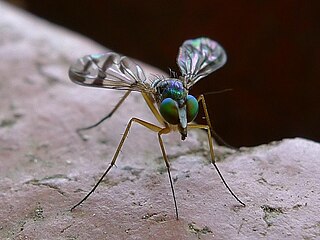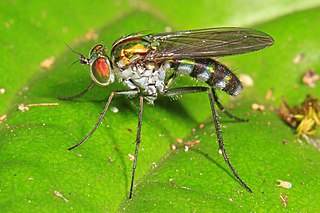
Dolichopodidae, the long-legged flies, are a large, cosmopolitan family of true flies with more than 8,000 described species in about 250 genera. The genus Dolichopus is the most speciose, with some 600 species.

Campsicnemus is a genus of flies in family Dolichopodidae. There are more than 290 described species, made up of 34 Palearctic, 22 Nearctic, seven Afrotropic, 170 Australasian and Oceanian, and seven Indomalayan species. Some species endemic to the Hawaiian islands are characterized by their lack of wings. After the introduction of invasive ants and other alien species such as wild boar (Sus scrofa) to the islands, some of these flightless species are believed extinct.

Dolichopus is a large cosmopolitan genus of flies in the family Dolichopodidae. Adults are small flies, typically less than 8 mm in length. Nearly all species are metallic greenish-blue to greenish-bronze. It is the largest genus of Dolichopodidae with more than 600 species worldwide.
Ceratopos is a genus of flies in the family Dolichopodidae, known from Algeria and Portugal. It contains only one species, Ceratopos seguyi. It is closely related to Syntormon, and is considered a junior synonym of it according to Evenhuis & Bickel (2022).
Cymatopus is a genus of flies in the family Dolichopodidae. Members of the genus are found on rocky coasts of the Indo-West Pacific.

Heteropsilopus is a genus of flies in the family Dolichopodidae. The genus comprises large-sized sciapodines mostly with a strongly sinuate m-cu and simple digitiform cercus. The strongly sinuate m-cu is considered to be a distinctive group autapomorphy.

Plagioneurus is a genus of long-legged flies in the family Dolichopodidae. It contains only one species, Plagioneurus univittatus, and is the only member of the subfamily Plagioneurinae. The range of P. univittatus spans from the Eastern United States south to South America.

Thinophilus is a genus of flies in the family Dolichopodidae. It includes about 146 described species distributed worldwide. Most species of the genus are found in coastal habitats, while a few species are found in freshwater habitats.
Wheelerenomyia is an extinct genus of flies in the family Dolichopodidae that lived during the Eocene of the Baltic region. The genus currently contains 13 species, all of which were described from Baltic amber. Within the family Dolichopodidae, Wheelerenomyia is considered to be a member of the subfamily Sciapodinae, but its wing vein M is unbranched and strongly curved so it is considered closely related to members of the tribe Mesorhagini. The genus was first described in 1907 by Fernand Meunier, who named it after William Morton Wheeler.

Sciapodinae is a subfamily of flies in the family Dolichopodidae. Members of the subfamily possess several ancestral characteristics of the family, such as branched vein M1+2 in the wings (though M2 is absent or reduced in Mesorhagini) and a pedunculate hypopygium. They also typically have a deeply excavated vertex, giving their heads the appearance of a dumbbell when viewed from the front.

Diaphorinae is a subfamily of flies in the family Dolichopodidae.
Cryptophleps is a genus of flies in the family Dolichopodidae.

Sympycninae is a subfamily of flies in the family Dolichopodidae. In some classifications, this subfamily includes the genera of the subfamilies Peloropeodinae and Xanthochlorinae.
Haromyia is a genus of flies in the family Dolichopodidae. It contains only one species, Haromyia iviei, known from Dominica. Flies in the genus and species have a small body size measuring between 1.0 to 1.5 mm in length, a bulging clypeus with six large setae, and wing veins that are nearly straight and evenly diverge from the base of the wing to the tip.
Shamshevia is a genus of flies in the family Dolichopodidae. It has a disjunct distribution, occurring in both the western Old World and the Fiji islands, and lives in varied ecological habitats. The genus is named after the Russian dipterist Igor Shamshev.
Mberu is a genus of flies in the family Dolichopodidae. It is known from the Atlantic Forest in southeastern Brazil, and contains only one species, Mberu pepocatu. The generic name is the Tupi–Guarani word for "fly". The specific name is a combination of the Tupi–Guarani words pepo ("wing") and cato ("beautiful"), referring to the vein pattern of the wings.
Hercostomoides is a genus of flies in the family Dolichopodidae. It is known from Asia to Australia and the western Pacific Ocean.

Microphorella is a genus of flies in the family Dolichopodidae. It is currently considered both paraphyletic and polyphyletic, and several species groups may need to be recognised as subgenera or genera.
Nothorhaphium is a genus of flies belonging to the family Dolichopodidae. It includes four species from Australia and a single species from New Guinea. Nothorhaphium superficially resembles the genus Rhaphium, but it belongs in the subfamily Sympycninae and is thought to be closely related to the genera Syntormon, Parasyntormon and Ceratopos. The name of the genus is derived from the Greek νόθος, and Rhaphium.








